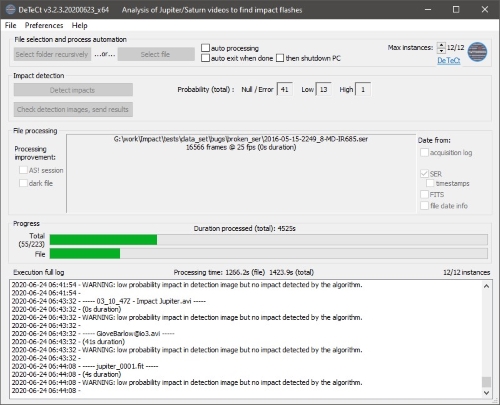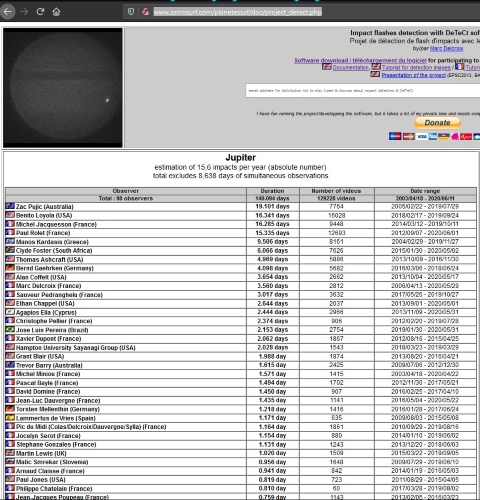- 1French Astronomical Society (SAF), Planetary observations commission, Tournefeuille, France (delcroix.marc@free.fr)
- 2Cheikh Anta Diop University, Dakar, Sénégal (salma.sylla@ucad.edu.sn)
- 3Paris Observatory, IMCCE, Paris, France
- 4Física Aplicada I, Escuela de Ingeniería de Bilbao, UPV/EHU, Bilbao, Spain (ricardo.hueso@ehu.es)
- 5Institut de Recherche pour le Développement, UMR5563, Géosciences Environnement Toulouse, IRD, CNRS et Université Toulouse III, Toulouse, France
Impact detection on Jupiter through amateurs’ processing of their own videos using DeTeCt
(delcroix.marc@free.fr)
(1) Societé Astronomique de France, Paris, France
(2) Université Cheikh Anta Diop, Dakar, Sénégal
(3) Observatoire de Paris, IMCCE, Paris, France
(4) Física Aplicada I, Escuela de Ingeniería de Bilbao, UPV/EHU, Bilbao, Spain
(5) Institut de Recherche pour le Développement, UMR5563, Géosciences Environnement Toulouse, IRD, CNRS et Université Toulouse III, Toulouse, France
Since 2010, amateur astronomers have discovered six flashes in Jupiter caused by the entry of small bodies in Jupiter’s atmosphere [1-5]. The last of these impact flashes was discovered thanks to a pro-am collaborative project called “DeTeCt”. This project is based on a software tool released to the amateur community that allows the observers themselves to analyze their video observations.
The software DeTeCt performs differential photometry to find sudden brightness variations, generates a detection image and a report. The detection image allows the users to do a quick look of the analysis and the reports and detection images are sent to two of us (MD, SS) for in depth analysis and statistics of the positive and negative detections. In this work we will see the latest evolutions of the project presenting the new features in the software, details of the detection algorithm and changes in the methodology of the statistical analysis.

Fig. 1: New GUI in the DeTeCt software.
This project has accumulated data acquired over 17 years of Jupiter observations. The total time covered by the videos analyzed is equivalent to 5 full months of observations. This has been possible only thanks to the active participation of a hundred of amateur astronomers worldwide. The accumulated time analyzed in the project allows a more accurate estimation of the impact frequencies on Jupiter [4]. The project website (http://www.astrosurf.com/planetessaf/doc/project_detect.php) maintains up to date results of the statistical analysis, and provides the software to download.

Fig. 2: Webpage of the project with statistics, estimation of the impact frequency and links to software and tutorial.
Additionally, observational campaigns were organized at Pic du Midi to acquire Jupiter and Saturn videos taking advantage of the excellent seeing of the site of observation. A large number of positive detections is expected based on the combination of an excellent seeing and the large diameter of the telescope (with respect to other observations campaigns, amateur astronomers’ telescopes diameters range from 15 to 50cm). The observation campaigns were generally organized around the opposition of Jupiter when the planet was high in the sky. Each night we could acquire at least two hours of video recording of the planet.
The scientific analysis of the different impacts allows to estimate the impact bodies in terms of the released energy and mean mass, which translates in ranges of possible sizes and density. Light curves of the more recent impacts allow to study impact fragmentation and possible densities of the impact body [5].
This project showcases the usefulness of amateur astronomers’ observations, who provide unique essential data for this scientific work.
References
[1] Hueso R. et al., 2010, «First Earth-based detection of a superbolide on Jupiter», The Astrophysical Journal Letters, 721, L129-L133.
[2] Hueso R., et al. (incl. M. Delcroix), 2013, «Impact flux in Jupiter: From superbolides to large-scales collisions», Astronomy & Astrophysics, 560, A55.
[3] Hueso R., M. Delcroix et al.,2018a, « Small impacts on the Giant planet Jupiter », Astronomy & Astrophysics 617, A68 pp1-13.
[4] Hueso R., del Rio-Gaztelurrutia, Sánchez-Lavega, Delcroix M. et al. 2018b, « Detectability of possible weather effects on Mars upper atmosphere and meteor impacts in Jupiter and Saturn with small telescopes », Journal of Space Weather and Space Climate, 123,3020-3034
[5] Sankar R. et al. (incl. M. Delcroix) 2020, « Fragmentation modelling of the August 2019 impact on Jupiter », Monthly Notices of the Royal Astronomical Society, 2020
How to cite: Delcroix, M., Sylla, S., Hueso, R., Colas, F., and Baratoux, D.: Impact detection on Jupiter through amateurs’ processing of their own videos using DeTeCt, Europlanet Science Congress 2020, online, 21 Sep–9 Oct 2020, EPSC2020-775, https://doi.org/10.5194/epsc2020-775, 2020.

